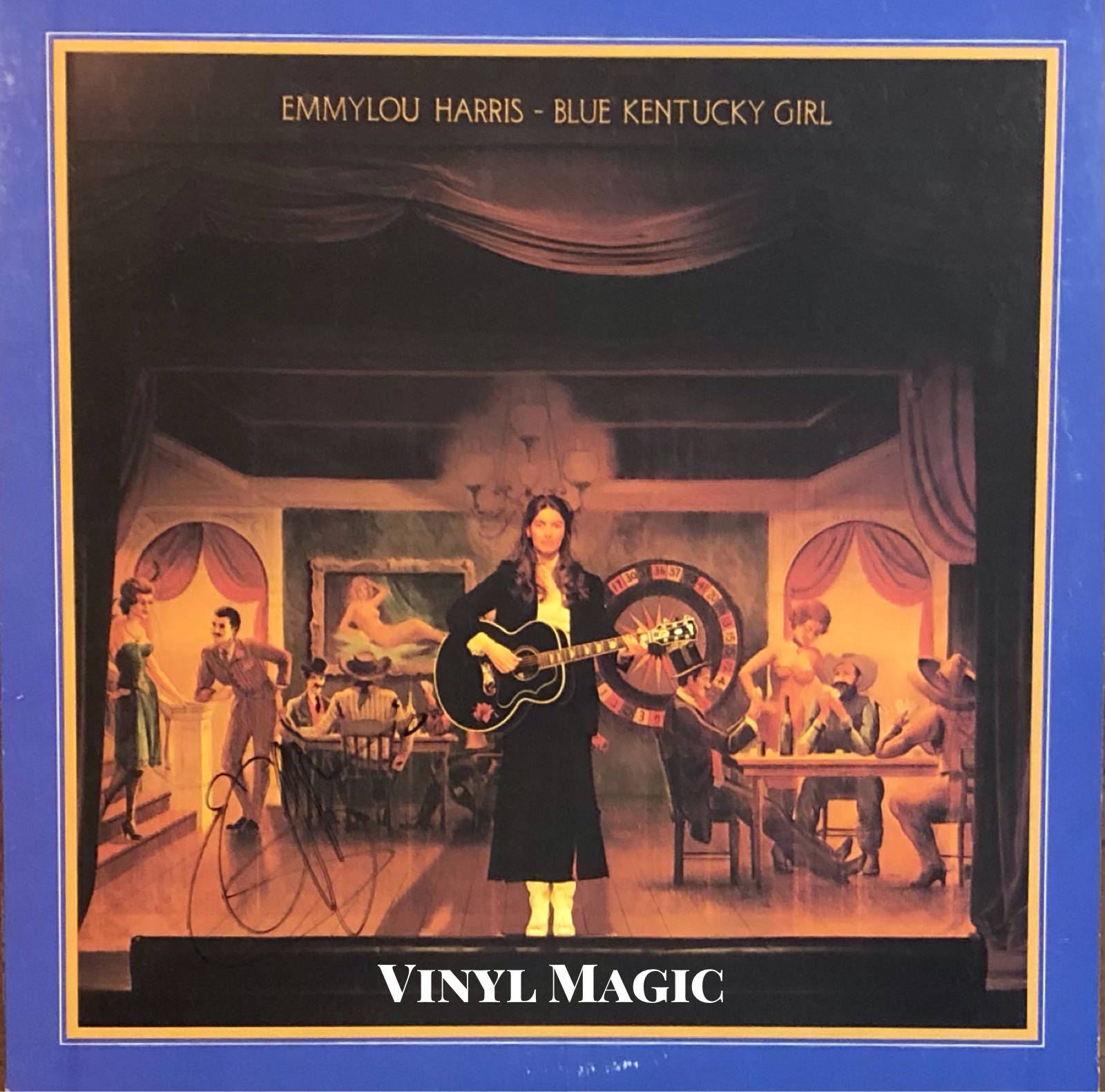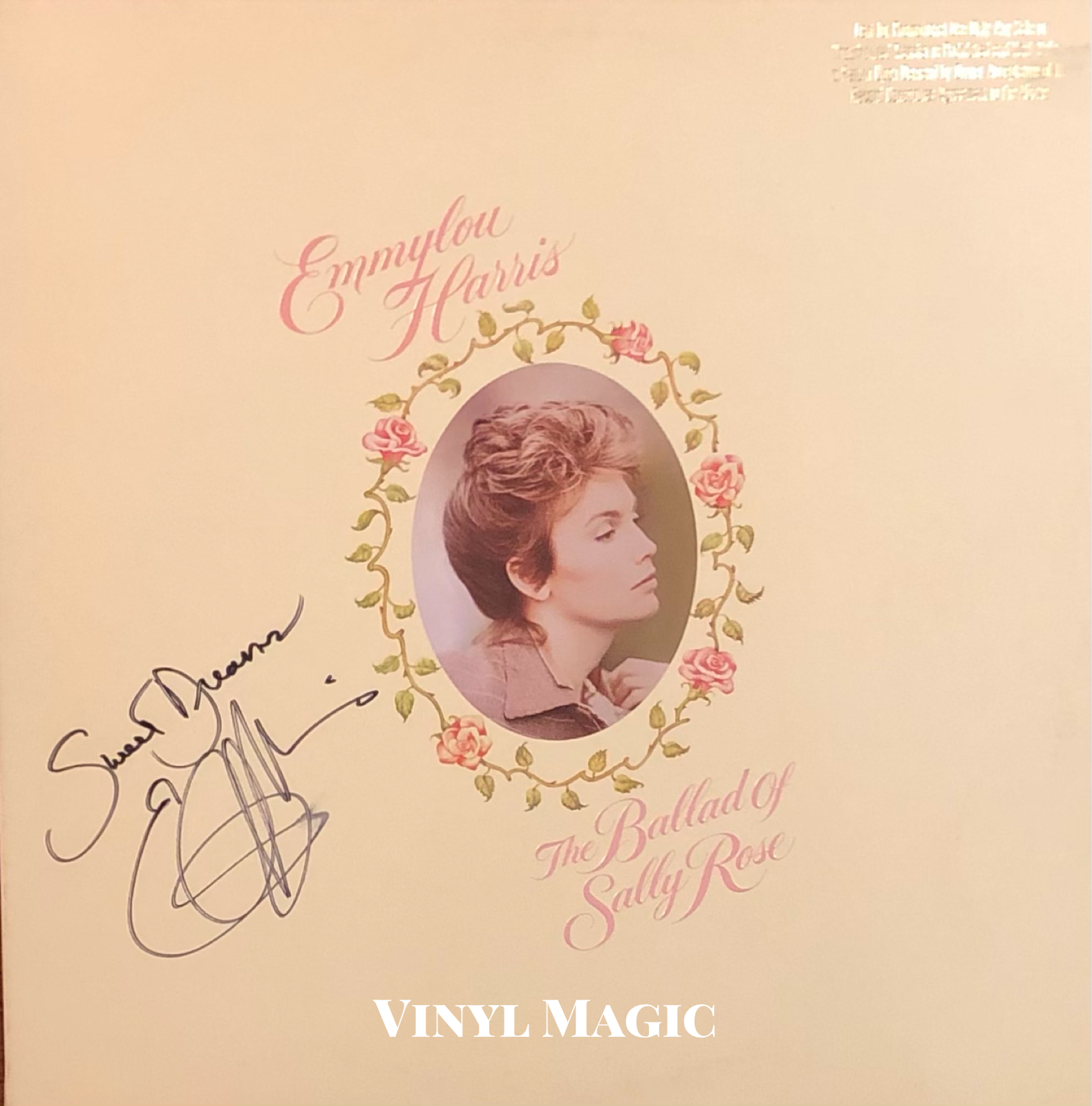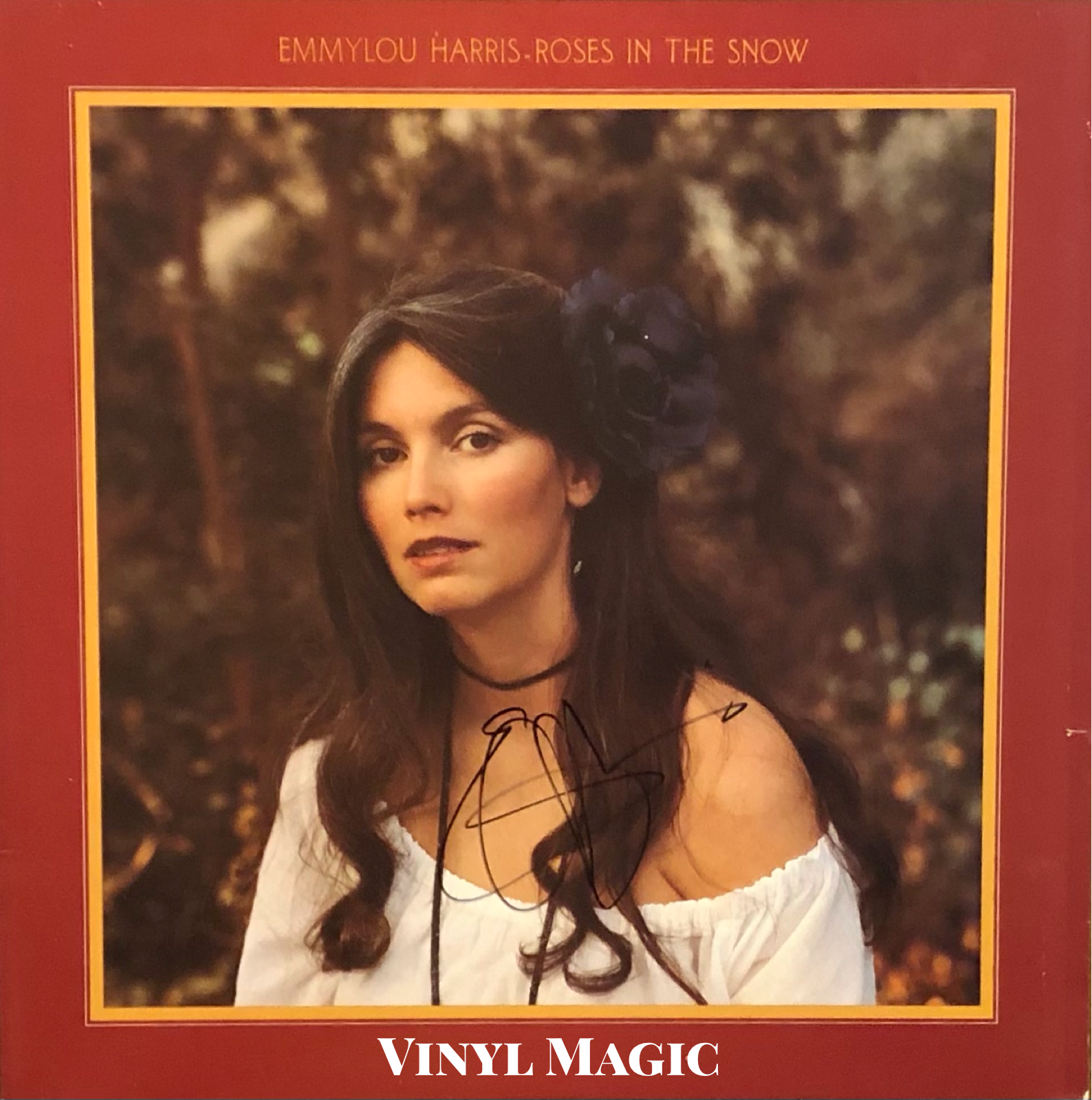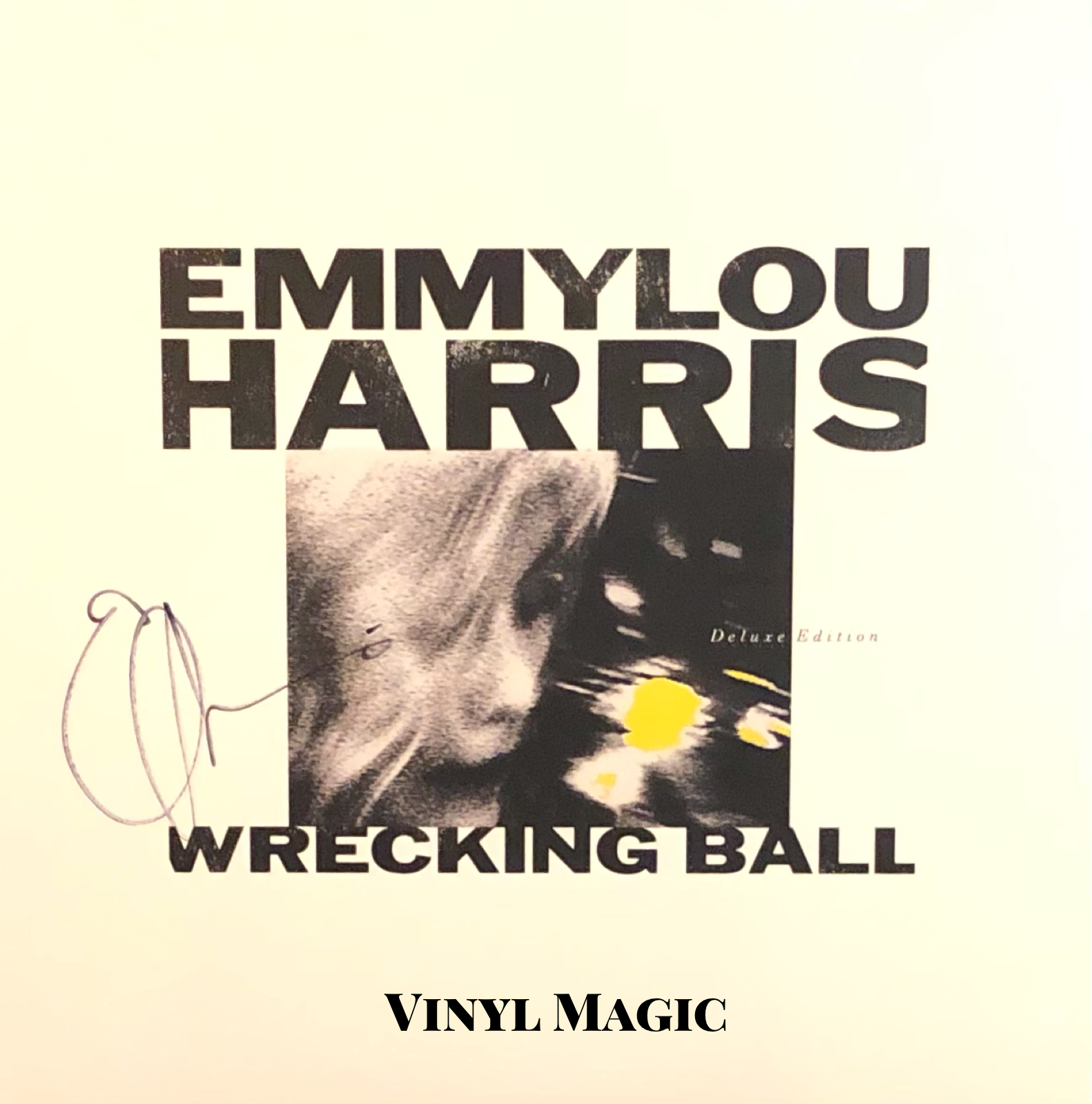Emmylou Harris, Daniel Lanois and Me...
I don't ever worry about whether I'm being true to my country roots. My country roots were adopted. I never worry about what I can do, or what I should do. I just do what I want to do.
Emmylou Harris
Luxury Liner (1977) signed by Emmylou
I was 21 when I moved to New York City. That’s pretty young, I guess. I didn’t know anyone except the wonderful singer-songwriter Paul Siebel, who introduced me to David Bromberg and Jerry Jeff Walker and all the people who were making music in the [Greenwich] Village. It was a very creative time. I started making music with friends, trying to get little gigs, learning my craft. I was very inspired by the people I heard play, like Joni Mitchell and Townes Van Zandt – I was quite astounded the first time I saw him. I never imagined I would end up recording “Pancho and Lefty,”;which became a real central part of my repertoire..
Emmylou Harris
Blue Kentucky Girl (1979) signed by Emmylou
I discovered my voice by singing harmonies with Gram (Parsons). That became a launching pad for everything. Rodney (Crowell) came in and filled that role in making the first record. It helped me a lot to have that voice to cling to. I’m not an educated musician; I don’t know what the baritone part is. Instead I think of harmony as an alternate melody that combines with the other voice to create a third voice.
Emmylou Harris
The Ballad Of Sally Rose (1985) signed by Emmylou
If I could go back to my younger self, especially in the most difficult times, I would just say, don’t worry. Just do what you feel in your heart and everything will be all right. Because it always did turn out okay. There was a time when I went into deep debt over a project, The Ballad of Sally Rose. But I don’t have any regrets about doing it at all because it was real creative reclaiming. After that I had to work my way back up but then, all of a sudden, I did this record called Trio with Linda Ronstadt and Dolly Parton, so the creative chances always seemed to come along. Certainly, there were times when it seemed like I was treading water. But I didn’t really have any other talents – the only thing I knew how to do was sing so, in a sense, I had no choice..
Emmylou Harris
Trio (1987) signed by Emmylou
I’d like to tell my younger self that though it will be very difficult when Gram dies, it will be okay again, eventually. That was a very hard time because I really felt I had found where I was supposed to be. Even though I probably assumed that at some point I would make a record on my own, that was something I wasn’t even thinking about. I just was thinking about what we would do together. Musically, I mean. Then suddenly I’d lost a friend and a teacher, someone I felt I still had so much to learn from. It was devastating. But I had wonderful support from my family and my musical friends, and they helped me take one step at a time. I was nourished and I gathered strength and was able to move forward.
Emmylou Harris
At The Roman (1992) signed by Emmylou
The Ryman was about to be torn down,. There were only a couple of funky dressing rooms, and you couldn’t sit in the gallery because it was considered unsafe. We could only invite 200 people for each of the three shows we recorded, because they could only sit downstairs. No one had been doing any music there, but I got permission. I was so focused on making the record that I didn’t realize the importance of doing it there. But suddenly people got interested in the Ryman again, and they decided not to tear it down. They said, ‘Maybe we can renovate the old girl.’
Emmylou Harris on helping save the Ryman Auditorium
Ramble In Music City (1990 recordings, 2021 release) signed by Emmylou
I was riding that pony a bit hard. My voice was getting worn down, and my spirit was getting worn too. I was whining to my friend John Starling, ‘I need to take a year off.’ And John said, ‘Sam Bush has just left the New Grass Revival. Why don’t you give him a call?’ And suddenly it made sense to ‘go back to bluegrass school,’ as Chris Hillman says.
None of us remembered that we’d recorded that show,. That’s why I was so amazed when I heard it, because not a single note was out of place. I felt I owed it to that particular performance to put it out. What happened, I think, was this: All the songs on Ramble in Music City were material I’d already released. For my next album, we decided to work up all new songs for what became Live at the Ryman, like I had with The Hot Band on Last Date.It was a way to make the old material new, to give it a new coat of paint. I was worried. Would the songs have the same emotional impact? I shouldn’t have worried.Emmylou, releasing Ramble In Music City in 202, 1990 recordings
White Shoes (1983) signed by Emmylou
I really have shaken hands with where my voice is right now. I think it's got a little deeper, it's got some more grooves in it.
Emmylou Harris
Gliding Bird (1969 recordings, 1978 reissue) signed by Emmylou
It doesn’t make a difference who’s the ‘lead singer,’ It’s all about creating that third voice. You start with an emotion, but it turns into something physical. Especially in duet singing, it’s intuitive; you’re free to move around. The lead voice is defining something that seems to work, and you move around that. It’s like you’re dancing together. Harmony singing is Ginger Rogers following Fred Astaire, but she’s doing everything backward in high heels.
Emmylou Harris singing with Gram Parsons
Cimarron (1981) signed by Emmylou
Born in Birmingham, Alabama to a military family, Emmylou Harris moved to Woodbridge, Virginia and graduated as the valedictorian of her high school class. After dropping out of college, she moved to Greenwich Village to participate in the folk scene in the late 1960s. Emmylou recorded her first release Gliding Bird in 1969 before relocating to the suburbs of Maryland in the early 1970s, and playing in local bars like the The Red Fox Inn in Bethesda, Maryland and The Childe Harold in Washington, DC. There, Chris Hillman of The Byrds saw her perform and recommended her to his friend Gram Parsons.
Roses In The Snow (1980) signed by Emmylou
Emmylou became a protege and performing partner of the great Gram Parsons until his untimely demise in 1973, They were together only a year but Gram's influence would last a lifetime. As she recalled, “I really believe no one would have paid me any attention if it wasn’t for Gram. When I met him I had not found my own voice. I was an imitator; you have to start that way. But I really do believe that it was Gram who gave me, not just my voice, but he taught me about understanding music and feeling music, the way it came through me. Of course, I certainly had something to build on, but he was that last rocket boost and, after that, everything kind of fell into place.”
In 1975, Emmylou began recording for Reprise Records, a label started by Frank Sinatra in 1960 and home to Jimi Hendrix, Neil Young, Frank Zappa and many others. Over her long and illustrious career, Emmylou has sold millions of records and garnered thirteen Grammys and counting.
Angel Band (1987) signed by Emmylou
Whether in a club, theater, music hall or, in recent years, headlining The Hardly Strictly Bluegrass Festival in San Francisco before hundreds of thousands, Emmylou puts on a fabulous show. She is always surrounded by consummate skilled musicians: Rodney Crowell, Ricky Skaggs, Vince Gill, Sam Bush, and Jerry Douglas are just a few of the string virtuosos who have performed in her bands. A fine interpreter of songs, she has also written classics like "Boulder To Birmingham", "Tulsa Queen", "Prayer In Open D", "Waltz Across Texas Tonight", and "Boy From Tupelo."
Wrecking Ball (1995) signed by Emmylou
In 1995, Emmylou released Wrecking Ball, a masterpiece produced by Daniel Lanois, best known for his work with U2, Bob Dylan, and Peter Gabriel. A brilliant album, it was quite a sonic departure for Emmylou as it veered more toward alternative rock than country. This was not your father's Grand Ol' Opry. Fiddles, banjos, and upright basses were replaced by bass pedals, electric mandolins, organ, percussion and lots of atmospherics. Lanois brought along some interesting musicians (Malcolm Burn, Larry Mullen Jr. of U2, Neil Young, Steve Earle, and Lucinda Williams) who performed a very challenging and diverse playlist.
Red Dirt Girl (2000) signed by Emmylou
Emmylou did a very brief tour with Daniel Lanois in support of Wrecking Ball in November 1995, and Erin and I saw her at the Keswick Theater in Glenside, Pennsylvania. A small venue, maybe 1000 seats, Keswick is a converted movie theater. Emmylou came on first with just her acoustic guitar and she beautifully strummed "My Songbird" and "Prayer In Open D" with her crystalline voice soaring. Then her band appeared: Daniel Lanois on electric guitar, Daryl Johnson on electric bass, and Brady Blade on drums. They tore into a blistering cover of Jimi Hendrix's "May This Be Love" which was equal parts distortion, fuzz and wah wah pedals. There was a smattering of boos from some in the crowd who wanted their country music served neat with gingham check, not snarling leather. The response was not quite as heretical as Dylan plugging in at Newport in 1965, and I didn't hear anyone yell "Judas", but it was unsettling to some in the audience. Undaunted, Emmylou and her band played most of her (then) new album and ended with a 10 minute scorching version of Lanois' swamp gospel burner "The Maker." The encore was a soulful version of William Bell's "You Don't Miss Your Water" from the fabled Stax canon of soul. Country meets Memphis near the New Orleans Bayou, it was an amazing band and performance.
Elite Hotel (1975) signed by Emmylou, fingers crossed “flipping”
After the show, we hung around to get some records signed, and it was bitterly cold, polar vortex cold before it became de rigueur. Emmylou was so kind, she invited us on the bus to provide warmth and comfort. She laughed when I pointed out the original Elite Hotel album cover which was deemed too offensive because her fingers were crossed. Subsequent albums were issued with the fingers air brushed to avoid the appearance of "flipping." She couldn't have been any more gracious, posing for pictures and signing away.
Elite Hotel (1975) signed by Emmylou, fingers air brushed, “no flipping “
I have seen Emmylou Harris many times over the years with other great musicians like Steve Earle, Buddy Miller, Willie Nelson and Jerry Jeff Walker, but there was nothing quite as memorable as that Keswick show and the brief tour she did with Daniel Lanois.
Diane, Emmylou And Me… Concert For Landmine Free World, Washington DC
Flying Shoes (1978) signed by Emmylou, Steve Earle, Townes Van Zandt
Tennessee Inaugural Ball back signed by Emmylou, Johnny Cash, Jerry Jeff Walker
Light Of The Stable (1979) signed by Rodney Crowell
Choice Emmylou Harris Cuts (per BKs request)
https://m.youtube.com/watch?v=Bbaz_T6BN3g
“Tulsa Queen” Old Grey Whistle Test 1976
https://www.youtube.com/watch?v=i6iGP9P5coM
“My Songbird” live with Buddy Miller 1997
https://www.youtube.com/watch?v=i3RdttpefBU
“May This Be Love” Emmylou shreds Jimi! 1995
https://www.youtube.com/watch?v=r1TIZYEa9J8&list=RDr1TIZYEa9J8&start_radio=1
“Blackhawk” Wrecking Ball 1995
https://www.youtube.com/watch?v=scX50O2hDkI
“Pancho And Lefty” Old Grey Whistle Test 1976
https://www.youtube.com/watch?v=xEb9dEMV3p8
“Making Believe” Old Grey Whistle Test 1977
https://www.youtube.com/watch?v=QZTwBRcZPuU
“Wrecking Ball” live with Buddy Miller 1997
https://www.youtube.com/watch?v=wWEQDyrbphE
“The Sweetest Gift” live with Dolly Parton, Linda Ronstadt 1977
https://www.youtube.com/watch?v=BpzK-c9Jxeg
“Calling My Children Home” live with Spyboy 1998
https://www.youtube.com/watch?v=Aur5KEaNtKc
“The Maker” with Willie Nelson, Daniel Lanoisk
https://www.youtube.com/watch?v=s-4ESw_cPxo
“The Maker” with Daniel Lanois NYC 1995
https://www.youtube.com/watch?v=YY2gNbJFKn8
“Gulf Coast Highway” live with Dave Matthews



















